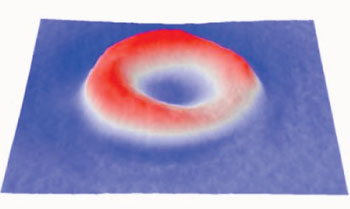Optical Interferometry Assays Stored Erythrocyte Function
By LabMedica International staff writers
Posted on 17 Sep 2014
The effect of the storage on the erythrocyte membrane deformability and morphology has been investigated using optical interferometry which can image red blood cell (RBC) topography with nanometer sensitivity.Posted on 17 Sep 2014
Stored red blood cells or erythrocytes undergo numerous biochemical, structural, and functional changes, commonly referred to as storage lesion and these changes can impede the ability of erythrocytes to perform their function and, as result, impact clinical outcomes in transfusion patients.

Image: The topography of a red blood cell as measured by the spatial light interference microscope (SLIM) optical technique. Though the cell keeps its shape as it ages, the membrane becomes less flexible (Photo courtesy of Prof. Gabriel Popescu).
Scientists and engineers at the University of Illinois at Urbana-Champaign (Urbana, IL, USA) used as source for RBC samples, packed red cells from donors collected in anticoagulant and preservation solution through the apheresis technique. The samples, two O+ and two A+, were obtained from saved segments of blood tube which is routinely attached to the blood unit in blood banks and maintained at 4 °C for the entire measurement period.
A sample chamber was created by punching a hole in a double sided scotch tape and sticking one side of the tape onto a poly-l-lysine coated cover slip (Neuvitro; El Monte, CA, USA). The sample is then pipetted into the chamber created by the hole and is sealed on the top using another cover slip. RBCs are allowed to settle for 45 minutes on the poly-l-lysine coated cover slip in order to avoid any cell movement prior to fast RBC imaging. A spatial light interference microscope (SLIM) was used where the optical layout is essentially a 4f-telecentric system. The SLIM was designed as an add-on module to a commercial phase contrast microscope the Axio Observer Z1 (Carl Zeiss Microscopy GmbH, Jena, Germany). Fast phase images were continuously recorded at 10 frames per second.
The team discovered that their measurements revealed a lot of characteristics stay the same over time as the cells retain their shape, mass and hemoglobin content. However, the membranes become stiffer and less elastic as time goes by. This is important because the blood cells need to be flexible enough to travel through tiny capillaries and permeable enough for oxygen to pass through. Increased stiffness in stored discocytes may be associated with reduction in post-transfusion survival and accelerate removal of transfused cells from the circulation. Availability of this dynamic membrane function assay may allow optimization of storage solution for RBCs with the objective of not only maintaining a normal RBC morphology but also normal membrane functionality.
Krishna Tangella, MD, a professor of pathology and a coauthor of the study said, “The results of this study can have a wide variety of clinical applications. Functional data from red blood cells would help physicians determine when to give red-cell transfusions for patients with anemia. This study may help better utilization of red-cell transfusions, which will not only decrease healthcare costs but also increase the quality of care.” The study was published on September 5, 2014, in the journal Scientific Reports.
Related Links:
University of Illinois at Urbana-Champaign
Neuvitro
Carl Zeiss Microscopy














